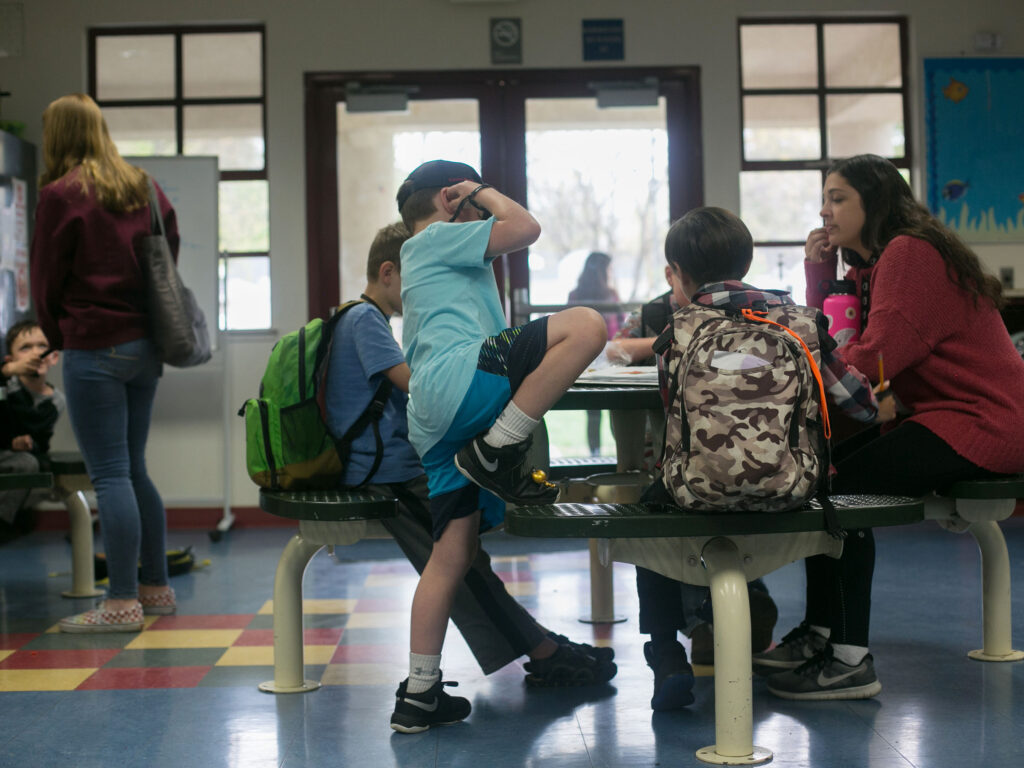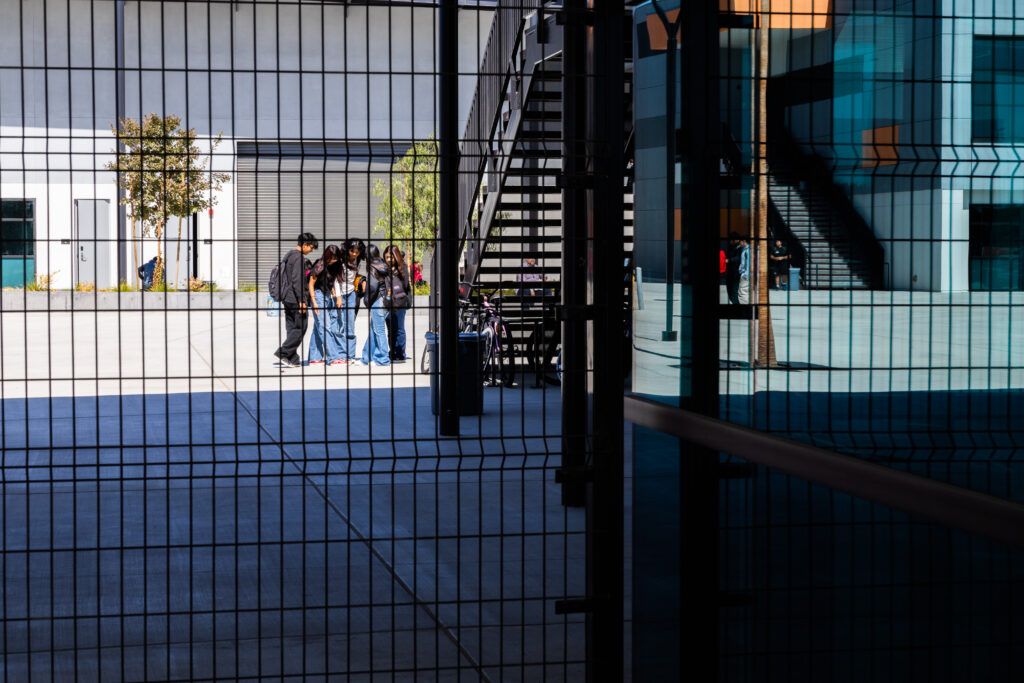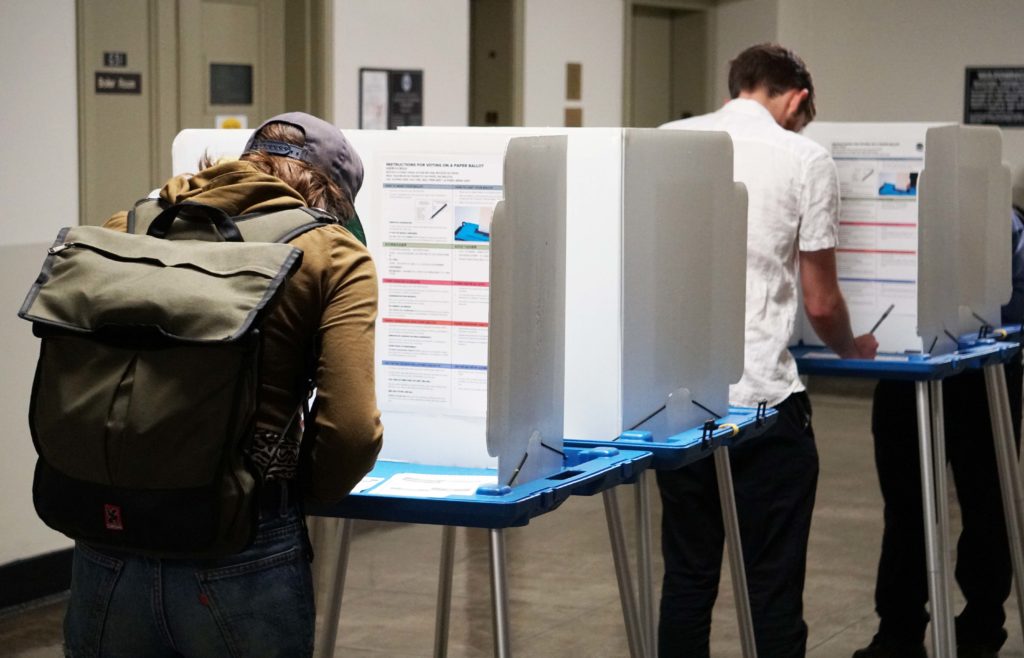
Students work on homework during an after-school program in Chico, the largest city in Butte County. (File photo)
Credit: Julie Leopo / EdSource
At 14, Charlotte Peery dropped out of high school.
“I was one of those silent sufferers,” Peery said. “I was battling with addiction, and once I finally decided I couldn’t go to school anymore, there wasn’t anyone around to say, ‘Well, let’s see what we can do’.”
It took another four years for Peery, raised in rural Tehama County, to return to school and enroll in an alternative education program. There, she met a counselor who provided the academic guidance and mental health counseling she needed to graduate from high school. Peery has since started earning her bachelor’s degree in social work and has become one of Tehama County schools’ first certified wellness coaches.
“When I had the opportunity to apply to be a wellness coach — it was everything I’ve always wanted to do — to provide the kind of support that I lacked when I needed it most,” Peery said.
As an entry-level wellness coach, Peery provides students with nonclinical support such as quick check-ins, screenings, referrals to specialists, structured mental health curriculum and outreach to their families.
Peery’s role is part of the state’s $4.6 billion Children and Youth Behavioral Health Initiative, for which the Department of Health Care Access and Information received $278 million to recruit, train and certify a diverse slate of mental health support personnel, known as certified wellness coaches, for schools and community-based organizations. Since February 2024, the department has hired over 2,000 certified wellness coaches.
“The wellness coach program helped define what coping skills and home-to-school services I could focus on,” said Jacque Thomas, who serves as a certified wellness coach II and is able to provide more in-depth services to students, such as individual 30-minute sessions focused on coping skills, goal-setting and life skills.
According to a 2021 study, 45% of California youth between the ages of 12 and 17 reported having struggled recently with mental health issues. The overall suicide rate in Tehama and neighboring counties is more than twice the state average, and according to a 2017-2019 survey, more than a third of 11th graders in Tehama County reported feelings of depression.
Research shows that children ages 2 to 8 in rural communities consistently have higher rates of mental, behavioral and developmental disorders than children in urban communities, largely due to financial difficulties and geographic isolation. Students in Tehama County tend to start struggling with mental health issues at a younger age, said Savannah Kenyon, a parent to a fourth grader and an education behavior assistant at Red Bluff High School.
“Our neighbors could be acres and acres away, and we don’t know them by name — so there’s a lot less socializing,” Kenyon said. “A lot of our students also come from a family of addiction or have to be the providers for their families.”
In Tehama County, nearly 1 in 5 children, and a third of children under the age of 5, live below the poverty line. The county also ranks sixth in California for the number of children who have experienced two or more adverse childhood events, such as abuse, neglect, substance use or mental health problems, known to have lasting impacts on health and well-being.
“It’s hard to see our children dealing with adult problems, and as a result, adult mental health problems, way younger,” Kenyon said.
Wellness coaches like Thomas and Peery try to understand students’ needs as they evolve. Thomas said that in the past school year, they saw an increase in students referred for substance use intervention, mirroring troubling rates of adolescent drug use and fatalities in the U.S.
In response to the increase in referrals, Thomas and Peery decided to become trained in Mindfully Based Substance Abuse Treatment, a program focused on building emotional awareness and examining cravings and triggers in youth substance use. In the process, they also learned about students dealing with unhealthy relationships or domestic violence at home. In response, Peery developed and ran a 16-week curriculum in three schools and a juvenile detention center, teaching students how to identify and respond to issues like abuse and family trauma.

Peery is often the first point of contact for a student struggling with mental health issues. On paper, her job spans the next two or three steps in the process — a mental health screening, a mindfulness and stress reduction session, or a referral to a specialist. But in practice, she hopes to strengthen the long-term network of care available to students. She has partnered with the Tehama County Department of Behavioral Health, which provides substance use recovery treatment, and Empower Tehama, which helps victims of domestic violence, for example.
“I’m making connections with drug and alcohol counselors and becoming more aware of which clinicians are accepting new clients once students transition out of our program,” Peery said. “To have that open communication, I’ve seen a huge shift in the way all of our partners are working together.”
School-based support is likely the most effective way to reach Tehama County students in need, she said, because most families cannot easily access major services, in part due to a disproportionate shortage of mental health providers,
“We’ve been able to provide more services to the farthest outreaches of our community and helped build rapport with every school,” Thomas said. “We go out to all 33 schools in the county to provide check-ins and open up the doors for our clinicians to meet with high-need students.”
Early intervention matters
After her daughter’s school shut down at the onset of the Covid-19 pandemic, just as she was starting transitional kindergarten, Kenyon noticed that her daughter was missing some key developmental milestones.
“We were realizing that the kids were not socializing at some of their peak times when they should be learning social skills,” Kenyon said. “I knew at an early age that she was going to be struggling with her ADHD (attention deficit hyperactivity disorder), so we knew that starting young was going to be the best way to help her in the long run.”
Early intervention for Kenyon’s daughter began with a screening and diagnosis of ADHD. From there, she said, her daughter’s counselor and teacher helped with little things like — motivating her through action-oriented feedback on her work, or teaching her mindful, deep breathing when she feels anxious — that allowed her daughter to handle emotional distress as well as social expression and inattentiveness in the classroom on a day-by-day basis.
“We’re always having open communication with the counselor or teacher. Being able to tell them, ‘We struggled last night, so she might be a little tired today; she might be a little bit emotional,’ has been imperative to her success,” Kenyon said.
Research shows that early, multidisciplinary interventions, such as a combination of school-based programs and family support initiatives, significantly reduce the risk of carrying mental health disorders into adulthood.
School shutdowns during the pandemic compounded the youth mental health crisis in California. About 65% of young people with depression did not receive treatment during the pandemic, while the rate of suicide among adolescents rose by 20%.
“We saw heightened anxiety, depression and delays in social development for students that had gone longer without intervention than they typically would have if they were on a school campus,” said JoNell Wallace, school mental health and wellness team coordinator at the Tehama County Department of Education. “We’re now starting interventions in third or fourth grade that we would’ve caught in second grade.”

Despite the additional support, Thomas said she has been flooded with students approaching her for help (“which is amazing,” she adds) and that students’ needs in Tehama County are still outpacing available staff and services at schools. She frequently eats in her car on the way to a counseling session, or sometimes skips lunch altogether, to fit another student into her schedule.
“You start to get stretched thin, and I don’t want any one student to have to be on a waitlist,” Thomas said.
Understaffing has also underscored the weaknesses of the referral system, a process through which schools assess students and refer them to wellness coaches, depending on the level of support they need. Schools do not always connect students to the support they need because of how time-consuming referrals can be.
“I think schools would much rather prefer it if we were on site,” Thomas said. “And that’s the goal — that more schools are qualified to have more wellness coaches, so their referral process will be in-house, and those services can start happening with a lesser barrier.”
There will be some relief starting this fall, when five additional certified wellness coaches will be placed at elementary and middle schools in Tehama County. Kenyon said the expanded service is a win for students like her daughter.
“She used to hide under the table if she got any type of feedback or if she felt like she had done something wrong,” Kenyon said. “But she hasn’t done it this entire year, which is such a big change from how she would try and escape her feelings.”
Now, with help from her counselors, coaches and teachers, her daughter comes home excited to talk about her day, feeling more confident and self-assured.
“Knowing that she’s coping, and for me to have help beyond just parental help — I know she’s a hundred percent supported through these programs,” Kenyon said.









